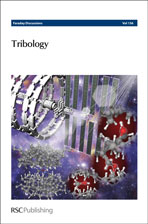Physio-chemical hydrodynamic mechanism underlying the formation of thin adsorbed boundary films
Abstract
The formation of low shear strength surface-adhered thin films mitigates excessive friction in mixed or boundary regimes of lubrication. Tribo-films are formed as a consequence of molecular chemical reactions with the surfaces. The process is best viewed in the context of a lubricant-surface system. Therefore, it is usually surmised that the adsorption of lubricant molecular species to the contact surfaces is underlying to the formation of ultra-thin lubricant films. The paper considers contact between smooth surfaces at close separation. This may be regarded as the contact of a pair of asperity summits, whose dimensions, however small, are far larger than the size of fluid molecules within the conjunction. In such diminishing separations the constraining effect of relatively smooth solid barriers causes oscillatory solvation of fluid molecules. This effect accounts for the conjunctional load capacity but does not contribute to mitigating friction, except when molecular
- This article is part of the themed collection: Tribology

 Please wait while we load your content...
Please wait while we load your content...